Dogs love belly rubs for both scientific and instinctive reasons.
When you rub your pup’s belly, it triggers the release of oxytocin, a feel-good hormone that strengthens your bond.
It’s also rooted in their evolutionary past, where exposing the belly was a sign of trust and submission in wild packs.
Physically, belly rubs activate nerve endings that create pleasurable sensations, while emotionally, they mimic maternal nurturing.
Your dog might show they want a belly rub by rolling over with a relaxed, wiggly posture.
However, not all dogs enjoy them, so it’s important to recognize your furry friend’s individual preferences.
There’s more to uncover about this canine quirk!
The Science Behind Belly Rubs
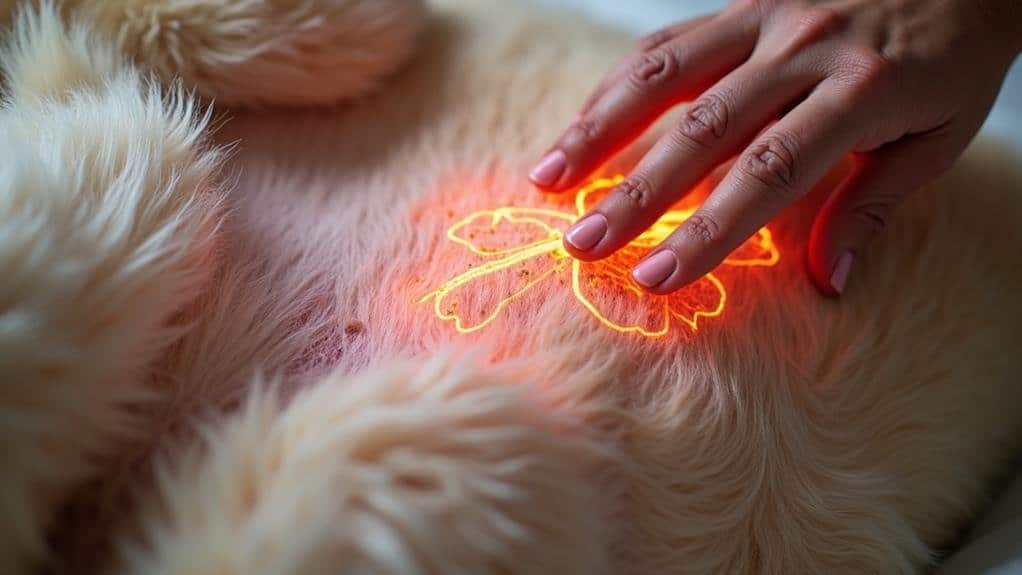
Oxytocin, often called the “love hormone,” plays a key role in why dogs enjoy belly rubs.
When you give your furry friend a good scratch on the tummy, you’re triggering a release of this powerful hormone, which promotes bonding and affection between you and your pup.
It’s not just a feel-good moment; science backs up the benefits of this simple act.
Here’s what happens during a belly rub:
- Oxytocin boost: Just three minutes of petting can greatly increase oxytocin levels in your dog.
- Stress reduction: At the same time, cortisol (the stress hormone) levels decrease.
- Scratch reflex activation: The belly rub stimulates nerve endings in your dog’s saddle region, creating pleasurable sensations.
These physical touches do more than just feel good; they contribute to your dog’s overall mental health and well-being.
Regular belly rubs can help reduce anxiety and stress levels in your four-legged friend.
Plus, this act mimics social grooming behaviors seen in canine packs, reinforcing trust and social connections between you and your dog.
Evolutionary Roots of Belly Exposure
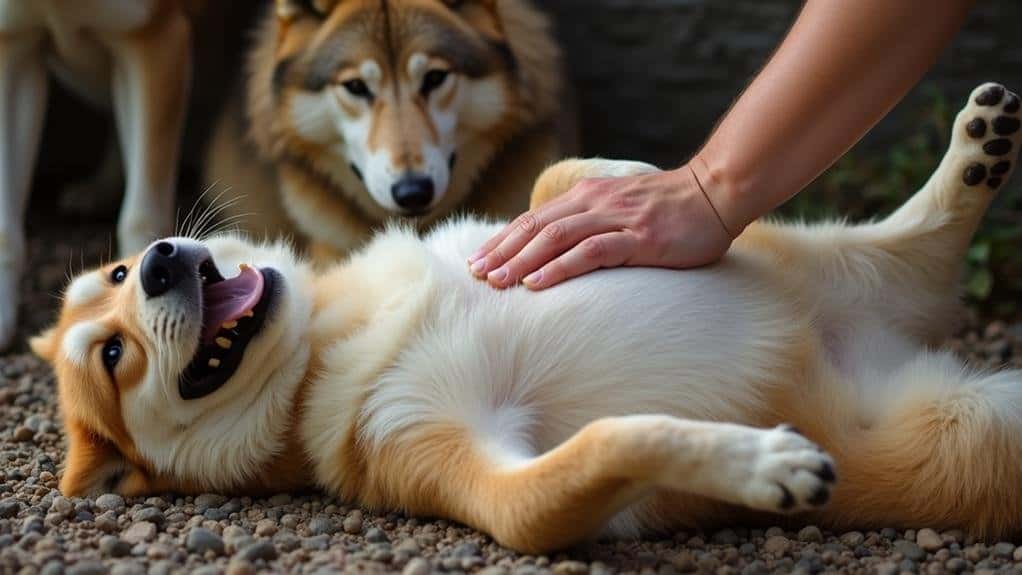
Surprisingly, your dog’s love for belly rubs has deep evolutionary roots.
When your furry friend rolls over and exposes their belly, they’re tapping into an ancient canine behavior that’s all about trust and social bonds.
This seemingly simple act is actually a complex display of submission and comfort that dates back to their wild ancestors.
Here’s why your dog’s belly-up behavior is so fascinating:
- Pack mentality: In wild canine packs, exposing the vulnerable belly area was a way to show submission and strengthen social bonds through allogrooming.
- Survival strategy: Dogs that displayed this submissive behavior were more likely to be accepted by the pack, increasing their chances of survival.
- Non-aggression signal: By rolling over, your dog is fundamentally saying, “I’m not a threat!” This helps diffuse tension in social situations.
- Trust indicator: When your pup shows you their belly, they’re demonstrating a high level of trust in you, reflecting the close bond formed through domestication.
- Comfort display: A dog who readily exposes their belly in your presence is showing how comfortable they feel around you, a reflection of your strong relationship.
Physical and Emotional Benefits
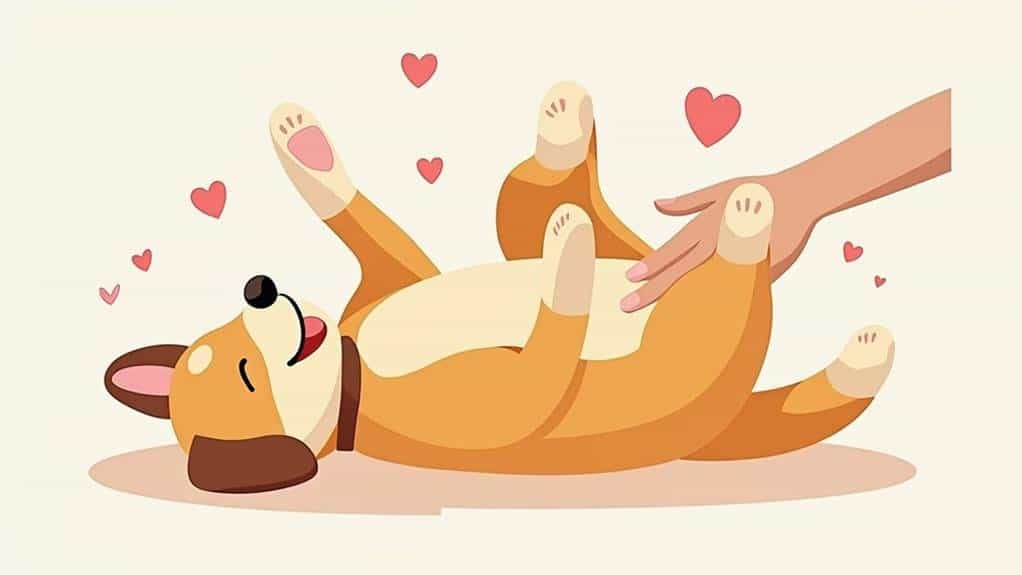
Beyond the evolutionary significance, belly rubs offer a wealth of physical and emotional benefits for your canine companion.
When you rub their bellies, you’re not just giving them a pleasant sensation; you’re activating a cascade of positive effects that contribute to their overall well-being.
1. Chemical Bonding:
Dogs love belly rubs because they trigger the release of oxytocin, often called the “love hormone.” This chemical strengthens the emotional bond between you and your furry friend, fostering trust and affection.
2. Stress Reduction:
As your dog enjoys belly rubs, their body produces endorphins, which are natural mood elevators. These feel-good chemicals help reduce stress and anxiety, promoting a sense of happiness and relaxation in your pet.
3. Comfort and Trust:
When you engage in this form of physical touch, you’re mimicking the nurturing care a mother dog provides to her puppies. This familiarity helps your dog feel safe and comfortable, reinforcing their trust in you.
4. Mental Health:
Regular belly rubs can improve your dog’s overall mental health, reducing the risk of behavioral issues linked to stress. It’s a simple yet effective way to keep your pup happy and well-adjusted.
Signs Your Dog Wants Rubs

Recognizing when your dog desires belly rubs can strengthen your bond and enhance your pet’s well-being.
Your furry friend has several ways of showing that they’re in the mood for some tummy attention. Here are the key signs to look out for:
- Body language:
- Your dog may display a loose, wiggly posture, indicating they’re relaxed and ready for affection.
- They might roll onto their back, exposing their belly – a clear invitation for rubs.
- Facial expressions:
- An open mouth with a relaxed tongue and bright or squinty eyes signals contentment and trust.
- Tail behavior:
- A relaxed, wagging tail is a happy indicator that your dog is comfortable and open to belly rubs.
- Vocalizations:
- Light panting or playful sounds often accompany a dog’s request for belly rubs, showing they enjoy the interaction.
When you notice these signs, it’s a great opportunity to give your pup some loving attention.
Belly Rubs and Bonding
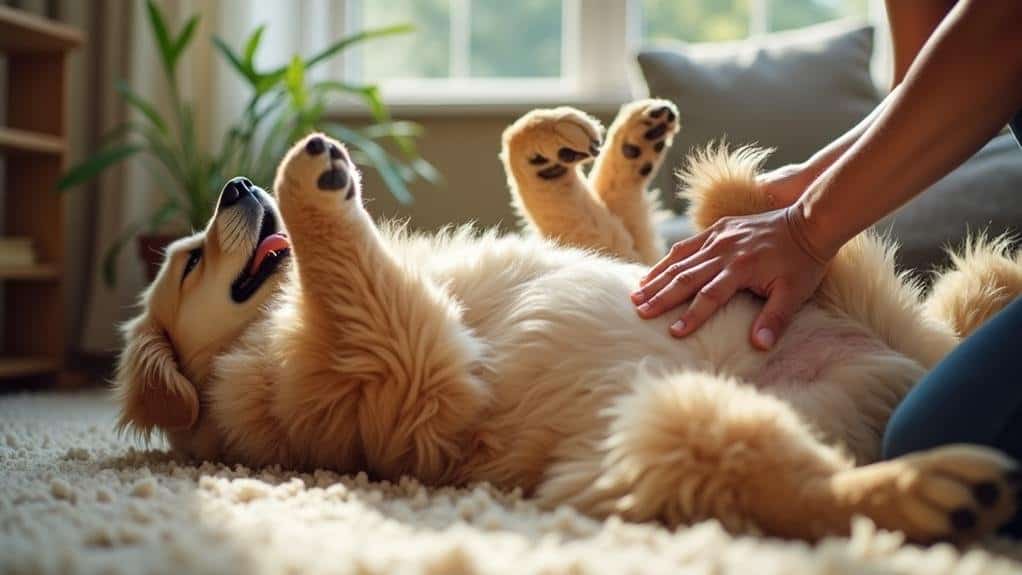
Belly rubs play a significant role in strengthening the bond between dogs and their human companions.
When you give your furry friend a belly rub, you’re not just making them feel good – you’re actively participating in a powerful bonding experience.
Here’s why belly rubs are so important for your relationship with your dog:
- Oxytocin release: Belly rubs trigger the release of oxytocin in both you and your dog. This “love hormone” fosters emotional connection and affection between you two.
- Social grooming: By engaging in belly rubs, you’re mimicking social grooming behaviors that dogs naturally use to bond with each other. This reinforces trust and strengthens your relationship.
- Desire for physical affection: When your dog seeks out belly rubs, they’re expressing their desire for physical affection and connection with you.
- Trust and vulnerability: Rolling over to expose their belly is a sign of trust. Your dog is showing you they feel safe and comfortable in your presence.
- Positive experiences: Regular belly rubs can enhance your dog’s overall mood and well-being, creating positive associations with you and deepening your emotional connection.
When Dogs Dislike Belly Rubs
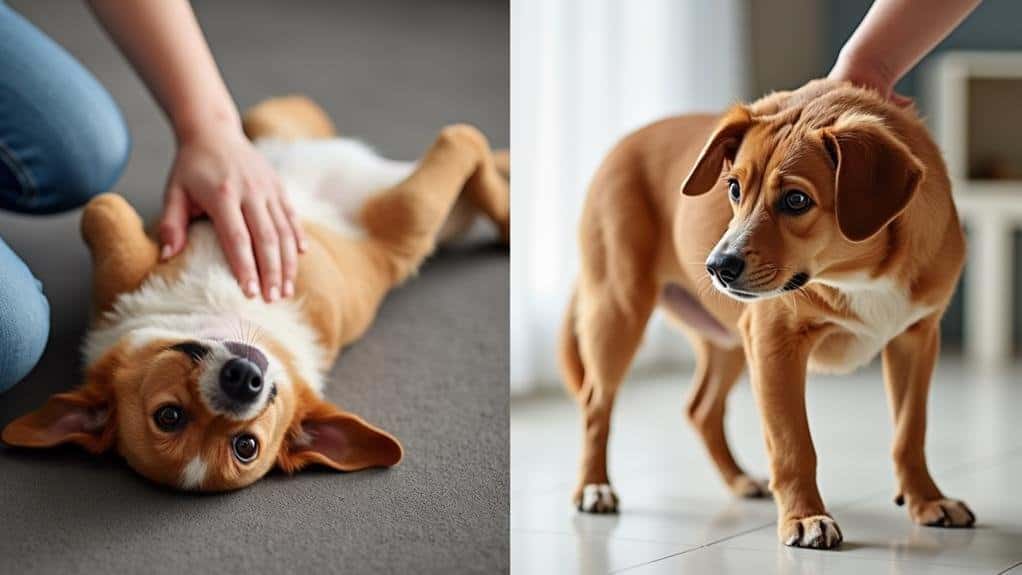
While many dogs adore belly rubs, it’s important to understand that not all canines share this enthusiasm.
Individual preferences vary greatly, and some dogs may actually dislike this form of affection.
As a pet owner, it’s essential to recognize and respect your dog’s boundaries.
Understanding Your Dog’s Body Language
- Watch for signs of stress: Lip-licking, stiff posture, and tucked tails can indicate discomfort.
- Observe their reaction: If your dog moves away or seems anxious, they may not enjoy belly rubs.
- Pay attention to breed differences: Some breeds may perceive belly rubs as aggressive rather than affectionate.
When Your Dog Dislikes Belly Rubs
If you notice your furry friend isn’t a fan of tummy tickles, don’t worry! There are plenty of other ways to show affection.
Alternative Forms of Canine Affection

If your furry friend isn’t keen on belly rubs, don’t fret. There are plenty of alternative forms of canine affection that can strengthen your bond and show your pup some love.
Understanding your dog’s individual preferences is key to a happy relationship.
- Gentle petting: Try softly stroking your dog’s chin or chest. Many dogs find this comforting, especially if they’re not fans of having their belly rubbed.
- Playtime: Engage in fun games or toy play. This not only shows affection but also reinforces positive behavior and deepens your connection.
- Verbal praise: Use a cheerful tone and encouraging words. Some dogs respond better to social interaction than physical touch, so don’t underestimate the power of your voice!
- Treats and rewards: Combine food rewards with affection for a double dose of love. While dogs often prefer owner contact, mixing treats with attention can enhance their emotional experience.
Frequently Asked Questions
Why Do Dogs Lay on Their Back and Want You to Rub Their Belly?
When dogs lie on their backs, they’re showing trust and inviting social interaction. You’ll notice they’re exposing their vulnerable belly, signaling they feel safe. It’s also a playful gesture and a way to cool off.
Why Do Dogs Like Their Tummy Rubbed?
Your dog loves tummy rubs because they trigger oxytocin release, promoting bonding and affection. It’s also a sign of trust and vulnerability. You’re stimulating endorphins, making your pup happier and less stressed while strengthening your emotional connection.
Do Dogs Get Pleasure From Belly Rubs?
Yes, your dog gets pleasure from belly rubs. They stimulate nerve endings, release feel-good hormones, and remind them of motherly comfort. You’ll notice their relaxed body language and leg kicking, indicating their enjoyment of your touch.
Why Does My Dog Go Crazy When I Rub His Belly?
Your dog goes crazy during belly rubs because you’re stimulating sensitive nerve endings in their saddle region. This triggers a pleasurable scratch reflex, causing excited reactions like leg kicking. It’s also releasing feel-good hormones, making them happy and playful.
Conclusion
You’ve now learned why your furry friend loves those belly rubs so much!
Remember, while most dogs enjoy this form of affection, always respect your pup’s preferences. Pay attention to their body language, and don’t force belly rubs if they’re not interested.
Whether it’s through belly rubs or other forms of interaction, the most important thing is spending quality time with your canine companion.
Keep building that bond, and you’ll both reap the rewards of a loving pet-owner relationship!

